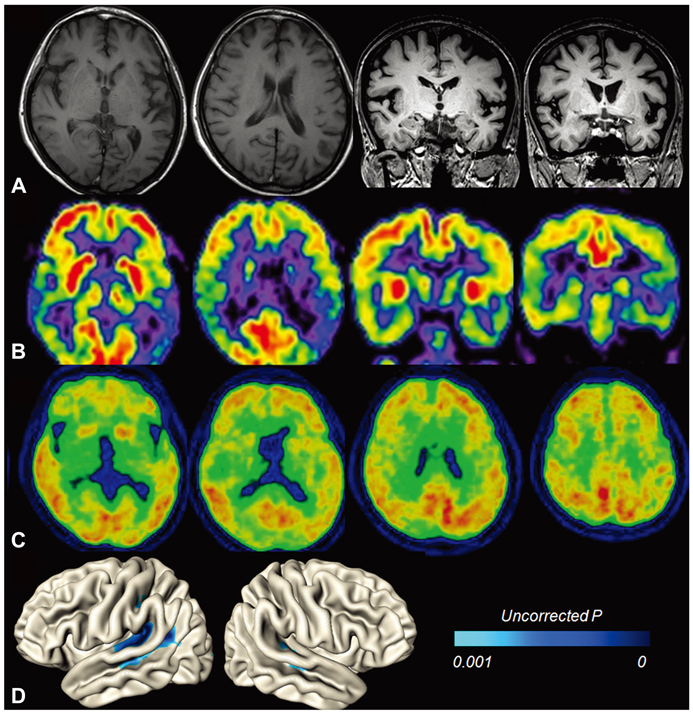J Clin Neurol.
2011 Dec;7(4):227-230. 10.3988/jcn.2011.7.4.227.
Pure Word Deafness in a Patient with Early-Onset Alzheimer's Disease: An Unusual Presentation
- Affiliations
-
- 1Department of Neurology, Konkuk University School of Medicine, Konkuk University Hospital, Seoul, Korea.
- 2Department of Neurology, Sungkyunkwan University School of Medicine, Samsung Medical Center, Seoul, Korea. dukna@skku.edu
- KMID: 2179009
- DOI: http://doi.org/10.3988/jcn.2011.7.4.227
Abstract
- BACKGROUND AND PURPOSE
The occurrence of PWD in neurodegenerative disease is very rare, and this is the first report of it being related to early-onset AD. We describe a patient with early-onset Alzheimer's disease (AD) who presented with pure word deafness (PWD).
CASE REPORT
The patient had experienced PWD for 2 years, followed by other cognitive deficits suggestive of parietotemporal dysfunction. Brain imaging including 18FDG-PET and [11C] PIB-PET supported the diagnosis of AD.
CONCLUSIONS
Our case highlights the clinical variability that characterizes early-onset AD.
MeSH Terms
Figure
Reference
-
1. Coslett HB, Brashear HR, Heilman KM. Pure word deafness after bilateral primary auditory cortex infarcts. Neurology. 1984. 34:347–352.
Article2. Denes G, Semenza C. Auditory modality-specific anomia: evidence from a case of pure word deafness. Cortex. 1975. 11:401–411.
Article3. Iizuka O, Suzuki K, Endo K, Fujii T, Mori E. Pure word deafness and pure anarthria in a patient with frontotemporal dementia. Eur J Neurol. 2007. 14:473–475.
Article4. Otsuki M, Soma Y, Sato M, Homma A, Tsuji S. Slowly progressive pure word deafness. Eur Neurol. 1998. 39:135–140.
Article5. Seo SW, Im K, Lee JM, Kim YH, Kim ST, Kim SY, et al. Cortical thickness in single- versus multiple-domain amnestic mild cognitive impairment. Neuroimage. 2007. 36:289–297.
Article6. Mesulam MM. Slowly progressive aphasia without generalized dementia. Ann Neurol. 1982. 11:592–598.
Article7. Kaga K, Shindo M, Tanaka Y. Central auditory information processing in patients with bilateral auditory cortex lesions. Acta Otolaryngol Suppl. 1997. 532:77–82.
Article8. Kaga K, Shindo M, Tanaka Y, Haebara H. Neuropathology of auditory agnosia following bilateral temporal lobe lesions: a case study. Acta Otolaryngol. 2000. 120:259–262.
Article9. Wirkowski E, Echausse N, Overby C, Ortiz O, Radler L. I can hear you yet cannot comprehend: a case of pure word deafness. J Emerg Med. 2006. 30:53–55.
Article10. Hayashi K, Hayashi R. Pure word deafness due to left subcortical lesion: neurophysiological studies of two patients. Clin Neurophysiol. 2007. 118:863–868.
Article11. Vitte E, Tankéré F, Bernat I, Zouaoui A, Lamas G, Soudant J. Midbrain deafness with normal brainstem auditory evoked potentials. Neurology. 2002. 58:970–973.
Article12. Jäncke L, Wüstenberg T, Scheich H, Heinze HJ. Phonetic perception and the temporal cortex. Neuroimage. 2002. 15:733–746.
Article


